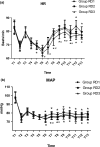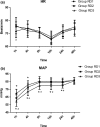Effect of intraoperative infusion of dexmedetomidine on postoperative recovery in patients undergoing endovascular interventional therapies: A prospective, randomized, controlled trial
- PMID: 31099992
- PMCID: PMC6625481
- DOI: 10.1002/brb3.1317
Effect of intraoperative infusion of dexmedetomidine on postoperative recovery in patients undergoing endovascular interventional therapies: A prospective, randomized, controlled trial
Abstract
Background: Rapid emergence from general anesthesia during endovascular interventional therapies (EITs) is important. However, the solution that improved quality of both analepsia and postoperative recovery after EITs has not been specifically addressed. We conducted this prospective, randomized, controlled trial to evaluate the intraoperative infusion of dexmedetomidine on quality of analepsia and postoperative recovery in patients undergoing EITs.
Methods: Eighty-six patients undergoing EITs were divided into three groups: RD1 (dexmedetomidine at an initial dose of 0.5 μg/kg for 10 min adjusted to 0.2 μg kg-1 hr-1 throughout EIT), RD2 (dexmedetomidine at an initial dose of 0.5 μg/kg for 10 min adjusted to 0.4 μg kg-1 hr-1 throughout EIT), and RD3 (dexmedetomidine at an initial dose of 0.5 μg/kg for 10 min adjusted to 0.6 μg kg-1 hr-1 throughout EIT). An analgesia system delivered sufentanil only. The primary outcome measure was the total consumption of nimodipine during the first 48 hr after surgery. The secondary outcome measures were sufentanil consumption, pain intensity, hemodynamics, functional activity score (FAS), neurologic examination, level of sedation (LOS), and Bruggrmann comfort scale (BCS). We also recorded the intraoperative hemodynamic data, requirement of narcotic and vasoactive drugs, prevalence of complications and symptomatic cerebral vasospasm, duration of postanesthesia care unit (PACU) stay, Glasgow Outcome Score (GOS) at 3 months, and prevalence of cerebral infarction 30 days after surgery.
Results: Dexmedetomidine application in the regimen RD3 reduced the consumption of the total dose of nimodipine and sufentanil 48 hr after surgery, prevalence of symptomatic cerebral vasospasm, consumption of narcotic drugs and nimodipine during surgery, pain intensity during the first 8 hr after surgery, and increased both BCS during the first 4 hr after surgery and hemodynamic stability. However, the LOS was increased at the 0.5 hr after surgery and surgeon satisfaction score was lower. There were no significant differences among the groups for consumption of vasoactive drugs except urapidil, Glasgow coma scale (GCS) and FAS during the first 48 hr after surgery, GOS at 3 months, and cerebral infarction after 30 days.
Conclusions: Dexmedetomidine (an initial dose of 0.5 μg/kg for 10 min adjusted to 0.6 μg kg-1 hr-1 throughout EIT) could reduce the total consumption of nimodipine and opioid during the first 48 hr after surgery, the concerning adverse effects, and improve pain scores. The optimal dosage of dexmedetomidine during EITs merits further investigation.
Keywords: cerebral vasospasm; dexmedetomidine; endovascular interventional therapies; neuroanesthesia; nimodipine.
© 2019 The Authors Brain and Behavior Published by Wiley Periodicals, Inc.
Conflict of interest statement
The authors declared that the research was conducted in the absence of any commercial or financial relationships.
Figures








Similar articles
-
The Nimodipine-Sparing Effect of Perioperative Dexmedetomidine Infusion During Aneurysmal Subarachnoid Hemorrhage: A Prospective, Randomized, Controlled Trial.Front Pharmacol. 2019 Aug 2;10:858. doi: 10.3389/fphar.2019.00858. eCollection 2019. Front Pharmacol. 2019. PMID: 31427968 Free PMC article.
-
Effect of Intraoperative and Postoperative Infusion of Dexmedetomidine on the Quality of Postoperative Analgesia in Highly Nicotine-Dependent Patients After Thoracic Surgery: A CONSORT-Prospective, Randomized, Controlled Trial.Medicine (Baltimore). 2015 Aug;94(32):e1329. doi: 10.1097/MD.0000000000001329. Medicine (Baltimore). 2015. PMID: 26266376 Free PMC article. Clinical Trial.
-
Intraoperative infusion of dexmedetomidine reduces perioperative analgesic requirements.Can J Anaesth. 2006 Jul;53(7):646-52. doi: 10.1007/BF03021622. Can J Anaesth. 2006. PMID: 16803911 Clinical Trial.
-
Perioperative analgesic profile of dexmedetomidine infusions in morbidly obese undergoing bariatric surgery: a meta-analysis and trial sequential analysis.Surg Obes Relat Dis. 2017 Aug;13(8):1434-1446. doi: 10.1016/j.soard.2017.02.025. Epub 2017 Mar 10. Surg Obes Relat Dis. 2017. PMID: 28396128 Review.
-
Effectiveness of dexmedetomidine versus propofol on extubation times, length of stay and mortality rates in adult cardiac surgery patients: a systematic review and meta-analysis.JBI Database System Rev Implement Rep. 2018 May;16(5):1220-1239. doi: 10.11124/JBISRIR-2017-003488. JBI Database System Rev Implement Rep. 2018. PMID: 29762314
Cited by
-
Cerebrospinal fluid metabolic profiling reveals divergent modulation of pentose phosphate pathway by midazolam, propofol and dexmedetomidine in patients with subarachnoid hemorrhage: a cohort study.BMC Anesthesiol. 2022 Jan 27;22(1):34. doi: 10.1186/s12871-022-01574-z. BMC Anesthesiol. 2022. PMID: 35086470 Free PMC article.
-
Effect of anesthesia induction with butorphanol on postoperative nausea and vomiting: A randomized controlled trial.World J Clin Cases. 2023 Nov 16;11(32):7806-7813. doi: 10.12998/wjcc.v11.i32.7806. World J Clin Cases. 2023. PMID: 38073686 Free PMC article.
-
Efficacy of dexmedetomidine in prevention of carotid artery stenting-induced intraoperative hypotension.Neurosurg Rev. 2025 Mar 27;48(1):331. doi: 10.1007/s10143-025-03466-5. Neurosurg Rev. 2025. PMID: 40146394
-
Economic and Humanistic Burden of Cerebral Vasospasm and Its Related Complications after Aneurysmal Subarachnoid Hemorrhage: A Systematic Literature Review.Neurol Ther. 2022 Jun;11(2):597-620. doi: 10.1007/s40120-022-00348-6. Epub 2022 Apr 20. Neurol Ther. 2022. PMID: 35441974 Free PMC article. Review.
-
Retrospective Comparison of the Safety and Effectiveness of Dexmedetomidine Versus Standard of Care Before and During Cesarean Delivery in a Maternity Unit in Zhengzhou, China.Med Sci Monit. 2020 Oct 24;26:e925709. doi: 10.12659/MSM.925709. Med Sci Monit. 2020. PMID: 33097682 Free PMC article.
References
-
- Albanna, W. , Weiss, M. , Müller, M. , Brockmann, M. A. , Rieg, A. , Conzen, C. , … Schubert, G. A. (2017). Endovascular rescue therapies for refractory vasospasm after subarachnoid hemorrhage: A prospective evaluation study using multimodal, continuous event neuromonitoring. Neurosurgery, 80(6), 942–949. 10.1093/neuros/nyw132 - DOI - PubMed
-
- Amadori, A. , Franchi, M. , Consoli, A. , Mencherini, N. , Palmarini, N. , Nappini, S. , … Mangiafico, S. (2013). Cooperative patient general anesthesia (Co.Pa.Ge.A.): The new anesthetic technique for neurological monitoring of the "cooperative" patient during endovascular treatment of elective brain arteriovenous malformations with Onyx18. Journal of Neurosurgical Anesthesiology, 25(3), 335–339. 10.1097/ANA.0b013e31828bac8d - DOI - PubMed
-
- Andereggen, L. , Beck, J. , Z'Graggen, W. J. , Schroth, G. , Andres, R. H. , Murek, M. , … Gralla, J. (2017). Feasibility and safety of repeat instant endovascular interventions in patients with refractory cerebral vasospasms. American Journal of Neuroradiology, 38(3), 561–567. 10.3174/ajnr.A5024 - DOI - PMC - PubMed
-
- Baguley, I. J. , Perkes, I. E. , Fernandez‐Ortega, J.‐F. , Rabinstein, A. A. , Dolce, G. , & Hendricks, H. T. (2014). Paroxysmal sympathetic hyperactivity after acquired brain injury: Consensus on conceptual definition, nomenclature, and diagnostic criteria. Journal of Neurotrauma, 31(17), 1515–1520. 10.1089/neu.2013.3301 - DOI - PubMed
Publication types
MeSH terms
Substances
LinkOut - more resources
Full Text Sources
Other Literature Sources
Medical
Research Materials
Miscellaneous

